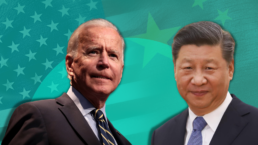Tensions are reaching a fever pitch, but there seems to be interest on both sides in ratcheting it down. The question is, can they?
By Ethan Paul, Responsible Statecraft
U.S. President Joe Biden and Chinese President Xi Jinping are expected to hold a virtual summit on Monday evening, their most high-profile meeting yet following phone calls in February and September. It comes at a moment of immense uncertainty and flux in the U.S.-China relationship, and its outcome has the potential to set the two sides on a course they will follow for the remainder of Biden’s presidency, for better or for worse.
Over recent months, tensions have reached a fever pitch on a number of issues, particularly Taiwan, China’s expanding nuclear arsenal, and the South China Sea. However, in contrast to the atmosphere of the first half of the year, this has been offset by a renewed urgency for greater dialogue and cooperation. Defense officials from both sides held talks for the first time in August, and followed this up with a second round in late September.

Trade negotiations have also resumed, apparently in earnest, with U.S. Trade Representative Katherine Tai saying on Wednesday that she is getting “traction” with her Chinese counterparts despite their differences. Renewed engagement has also achieved some tangible, and for many observers surprising, wins: the two sides resolved a three-year diplomatic dispute involving Huawei CFO Meng Wanzhou and two Canadian citizens detained in China, and also unveiled a joint declaration at the COP26 conference in Glasgow this week which promised enhanced near-term action on climate change.
Recent Posts
“Arrest Now, Ask Questions Later”: Why Did L.A. ICE Agents Arrest and Jail U.S. Citizen Andrea Velez?
July 3, 2025
Take Action Now “They didn’t have vests that said ICE or anything. Their cars didn’t have license plates. … Just because of the color of our…
Trump’s Big, Beautiful Bill Is Naked Class War
July 3, 2025
Take Action Now Trump’s “Big, Beautiful Bill” trades tax cuts on millionaires for the dissolution of society.By Hamilton Nolan, In These Times…
Mayor Mamdani’s First Day, A Zero Hour Conversation With Richard Wolff
July 2, 2025
Take Action Now If elected, what would Mayor Mamdani do on his first day in City Hall? How would a democratic socialist govern as a big-city mayor?……
The U.S. Is Funding A Bloodbath At Gaza Aid Centers
July 2, 2025
Take Action Now The admin just gave $30M to GHF, the organization at the center of charges that Israel is weaponizing assistance and shooting at…




